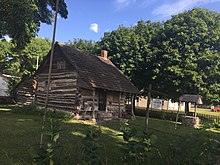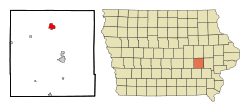|
Marengo, Iowa
Marengo is a city in and the county seat of Iowa County, Iowa, United States.[2] It has served as the county seat since August 1845, even though it was not incorporated until July 1859.[3] The population was 2,435 in the 2020 census, a decline from 2,535 in 2000.[4] HistoryMarengo was laid out in 1845 and platted in 1847.[5] The city's name commemorates the Battle of Marengo, where Napoleon defeated the Austrian army.[6] The Iowa County Courthouse, built in 1893, is on the National Register of Historic Places. Underground RailroadIn 1859, abolitionist John Brown led a group of escaped slaves from Missouri to Michigan. On February 20, the group stayed at the Draper B. Reynolds Farm 1.5 miles south of Marengo.[7] GeographyAccording to the United States Census Bureau, the city has a total area of 2.14 square miles (5.54 km2), of which 2.08 square miles (5.39 km2) is land and 0.06 square miles (0.16 km2) is water.[8] The Iowa River passes north of town. Demographics
2020 censusAs of the census of 2020,[10] there were 2,435 people, 1,057 households, and 615 families residing in the city. The population density was 1,151.2 inhabitants per square mile (444.5/km2). There were 1,147 housing units at an average density of 542.3 per square mile (209.4/km2). The racial makeup of the city was 93.3% White, 0.2% Black or African American, 0.1% Native American, 0.5% Asian, 0.0% Pacific Islander, 1.1% from other races and 4.7% from two or more races. Hispanic or Latino persons of any race comprised 4.1% of the population. Of the 1,057 households, 26.7% of which had children under the age of 18 living with them, 41.4% were married couples living together, 7.8% were cohabitating couples, 30.8% had a female householder with no spouse or partner present and 20.0% had a male householder with no spouse or partner present. 41.8% of all households were non-families. 35.1% of all households were made up of individuals, 16.8% had someone living alone who was 65 years old or older. The median age in the city was 41.7 years. 24.8% of the residents were under the age of 20; 5.8% were between the ages of 20 and 24; 22.8% were from 25 and 44; 25.5% were from 45 and 64; and 21.1% were 65 years of age or older. The gender makeup of the city was 48.5% male and 51.5% female. 2010 censusAs of the census[11] of 2010, there were 2,528 people, 1,059 households, and 648 families living in the city. The population density was 1,215.4 inhabitants per square mile (469.3/km2). There were 1,154 housing units at an average density of 554.8 per square mile (214.2/km2). The racial makeup of the city was 97.3% White, 0.6% African American, 0.6% Native American, 0.4% Asian, 0.4% from other races, and 0.7% from two or more races. Hispanic or Latino of any race were 2.8% of the population. There were 1,059 households, of which 30.5% had children under the age of 18 living with them, 45.2% were married couples living together, 10.3% had a female householder with no husband present, 5.7% had a male householder with no wife present, and 38.8% were non-families. 34.4% of all households were made up of individuals, and 17.2% had someone living alone who was 65 years of age or older. The average household size was 2.31 and the average family size was 2.94. The median age in the city was 41 years. 24.9% of residents were under the age of 18; 6.9% were between the ages of 18 and 24; 24% were from 25 to 44; 26.2% were from 45 to 64; and 18.1% were 65 years of age or older. The gender makeup of the city was 47.9% male and 52.1% female.  2000 censusAs of the census[12] of 2000, there were 2,535 people, 1,057 households, and 658 families living in the city. The population density was 1,210.5 inhabitants per square mile (467.4/km2). There were 1,135 housing units at an average density of 542.0 per square mile (209.3/km2). The racial makeup of the city was 98.11% White, 0.28% African American, 0.04% Native American, 0.67% Asian, 0.28% from other races, and 0.63% from two or more races. Hispanic or Latino of any race were 1.14% of the population. There were 1,057 households, out of which 30.4% had children under the age of 18 living with them, 48.9% were married couples living together, 9.5% had a female householder with no husband present, and 37.7% were non-families. 32.9% of all households were made up of individuals, and 16.5% had someone living alone who was 65 years of age or older. The average household size was 2.32 and the average family size was 2.98. Age spread: 25.4% under the age of 18, 6.9% from 18 to 24, 27.5% from 25 to 44, 21.5% from 45 to 64, and 18.7% who were 65 years of age or older. The median age was 38 years. For every 100 females, there were 88.9 males. For every 100 females age 18 and over, there were 85.5 males. The median income for a household in the city was $36,509, and the median income for a family was $47,153. Males had a median income of $32,986 versus $21,401 for females. The per capita income for the city was $17,425. About 6.1% of families and 7.3% of the population were below the poverty line, including 6.5% of those under age 18 and 11.9% of those age 65 or over. Arts and cultureLibrary The Marengo Public Library is a Carnegie library, constructed in 1904–1905. Marengo is believed to be the smallest town in the United States to have received a donation from Andrew Carnegie for the construction of a library. The Library completed a renovation and addition in May 2007.[13] Pioneer Heritage MuseumThe Iowa County Historical Society operates the Pioneer Heritage Museum, located at 675 East South St., Marengo. The museum houses two log cabins and a farmhouse, relocated from other sites in the area; and displays of farm implements, household artifacts, clothing and military history items from local residents.  It has a Chicago Rock Island RR depot relocated from Victor, Iowa and a 1930s filling station relocated from Hartwick, Iowa.[14]  Rolle Bolle CourtsMarengo's Rolle Bolle courts are located at the intersection of Marengo Avenue and E May Street, Marengo.  The traditional yard game (known as krulbollen in Belgium) was brought to the area by Belgian immigrants in the late 19th and early 20th centuries.[15] It is played by many local residents as well as by people in the neighboring towns of Victor, Clutier, Belle Plaine, Ladora, and Blairstown. EducationLocal public schools in Marengo include Iowa Valley Elementary School and Iowa Valley Junior Senior High School, part of the Iowa Valley Community School District. The Iowa Valley Junior High and High School teams are the Tigers. The Iowa Valley Tigers were the dominant 1985 State Champions in Track and Field for Class 2A, winning 45 points over the second place team's 31.50.[16] This included Matt Zuber's Class 2A records in the long jump (24'-3") and the 110 meter high hurdles (14.1 sec).[17] Notable people
See alsoReferences
External linksWikimedia Commons has media related to Marengo, Iowa.
|
||||||||||||||||||||||||||||||||||||||||||||||||||||||||||||||||||||||||||||||||||||||||||||||||||||||||||||||||||||||||||||


